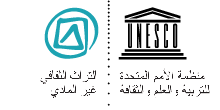التلمساني الزفافي الزي بعادة المرتبطة الحرفية المهارات و الطقوس
سجل في 2012 (7.COM) على القائمة التمثيلية للتراث الثقافي غير المادي للبشرية
بلد(ان): الجزائر
تعريف
Description

- التلمساني الزفافي الزي بعادة المرتبطة الحرفية المهارات و الطقوس
- © Belkaïd, 2011
عذراً، هذه الصفحة غير متوفرة باللغة العربية
The wedding ritual of Tlemcen in northwestern Algeria commences in the parents’ home, where the bride is dressed in a traditionally woven golden silk dress, surrounded by her friends and married female relations, the latter wearing their own wedding costumes. Symbolic henna designs are applied to her hands, and an older woman helps her don a caftan of embroidered velvet, jewellery and a conical hat. Rows of baroque pearls protect her vital and reproductive organs against evil spirits. On leaving the house, the bride is covered with a golden veil of silk. During the wedding feast a married woman from the bride’s inner circle draws red and silver designs beneath the veil on the bride’s cheeks and under her lower lip to purify and protect her. Once protected by her caftan, jewels and make-up, the bride removes her veil, ready to be wed. Girls in Tlemcen are initiated into the costume tradition at an early age, while the craftsmanship involved in making the precious wedding costume is transmitted from generation to generation. The rite symbolizes the alliance between families and continuity between generations, while the craftsmanship plays a major role in perpetuating the creativity and identity of the Tlemcen community.مستندات
عرض الشرائح
فيديو
© © CHRPAH, 2012
يمكن استعراض مقاطع الفيديو هذه (بالإضافة إلى العديد غيرها) من خلال موقع أرشيف اليونسكو للملتميديا”















